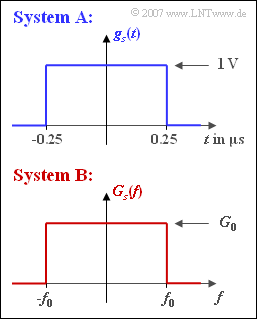Exercise 1.6Z: Two Optimal Systems
From LNTwww
Consider two binary transmission systems $\rm A$ and $\rm B$, which have the same error behavior for an AWGN channel with noise power density $N_{0}$. In both cases, the bit error probability is:
- $$p_{\rm B} = {\rm Q} \left( \sqrt{{2 \cdot E_{\rm B}}/{N_0}}\right)\hspace{0.05cm}.$$
- System $\rm A$ uses the NRZ basic transmission pulse $g_{s}(t)$ according to the upper sketch with amplitude $s_{0} = 1 \ \rm V$ and duration $T = 0.5\ \rm µ s$.
- In contrast, system $\rm B$, which is to operate at the same bit rate as system $\rm A$, has a rectangular basic transmission pulse spectrum:
- $$G_s(f) = \left\{ \begin{array}{c} G_0 \\ 0 \\ \end{array} \right.\quad \begin{array}{*{1}c} {\rm{for}} \\ {\rm{for}} \\ \end{array}\begin{array}{*{20}c} |f| < f_0 \hspace{0.05cm}, \\ |f| > f_0 \hspace{0.05cm}.\\ \end{array}$$
Notes:
- The exercise belongs to the chapter "Optimization of Baseband Transmission Systems".
- Here, the pulse amplitude is given in "volts", so that the average energy per bit $(E_{\rm B})$ has the unit $\rm V^{2}/Hz$.
Questions
Solution
(1) Both systems operate according to the specification with the same bit rate.
- The NRZ basic transmission pulse of system $\rm A$ has the symbol duration $T = 0.5\ \rm µ s$.
- This results in the bit rate $R = 1/T$ $ \underline{= 2\ \rm Mbit/s}$.
(2) The energy of the NRZ basic transmission pulse of system $\rm A$ is given by
- $$E_{\rm B} = \int_{-\infty}^{+\infty}g_s^2 (t)\,{\rm d} t = s_0^2 \cdot T = {1\,{\rm V^2}}\cdot {0.5 \cdot 10^{-6}\,{\rm s}}\hspace{0.1cm}\underline { = 0.5 \cdot 10^{-6}\,{\rm V^2/Hz}}\hspace{0.05cm}.$$
(3) The first two statements are true:
- In both cases $h_{\rm E}(t)$ must be equal in form to $g_{s}(t)$ and $H_{\rm E}(f)$ must be equal in form to $G_{s}(f)$.
- Thus, for system $\rm A$, the impulse response $h_{\rm E}(t)$ is rectangular and the frequency response $H_{\rm E}(f)$ is sinc-shaped.
- For system $\rm B$, $H_{\rm E}(f)$ is rectangular like $G_{s}(f)$ and thus the impulse response $h_{\rm E}(t)$ is an sinc-function.
- Statement 3 is false: An in $\rm A$, B.
(4) For system B $G_{d}(f)$ nearly coincides with $G_{s}(f)$.
- There is only a difference in the Nyquist frequency, but this does not affect the considerations here:
- While $G_{s}(f_{\rm Nyq}) = 1/2$, $G_{d}(f_{\rm Nyq}) = 1/4$.
- This results in a Nyquist system with rolloff factor $r = 0$.
- From this follows for the Nyquist frequency from the condition that the symbol duration should also be $T = 0.5\ \rm µ s$:
- $$f_{\rm 0} = f_{\rm Nyq} = \frac{1 } {2 \cdot T} = \frac{1 } {2 \cdot 0.5 \cdot 10^{-6}\,{\rm s}}\hspace{0.1cm}\underline {= 1\,{\rm MHz}}\hspace{0.05cm}.$$
(5) For the energy of the basic transmission pulse can also be written:
- $$E_{\rm B} = \int_{-\infty}^{+\infty}|G_s(f)|^2 \,{\rm d} f = G_0^2 \cdot 2 f_0\hspace{0.05cm}.$$
- Using the results from (2) and (4), it follows:
- $$G_0^2 = \frac{E_{\rm B}}{2 f_0} = \frac{5 \cdot 10^{-7}\,{\rm V^2/Hz}}{2 \cdot 10^{6}\,{\rm Hz}}= 2.5 \cdot 10^{-13}\,{\rm V^2/Hz^2} \hspace{0.3cm}\Rightarrow \hspace{0.3cm}G_0 \hspace{0.1cm}\underline {= 0.5 \cdot 10^{-6}\,{\rm V/Hz}} \hspace{0.05cm}.$$
(6) Solution 1 is correct:
- System A represents the optimal system even with peak limitation.
- On the other hand, system B would be unsuitable due to the extremely unfavorable crest factor.
